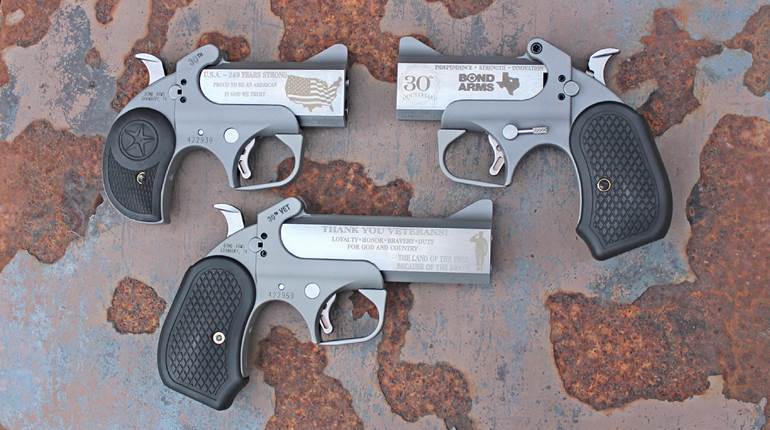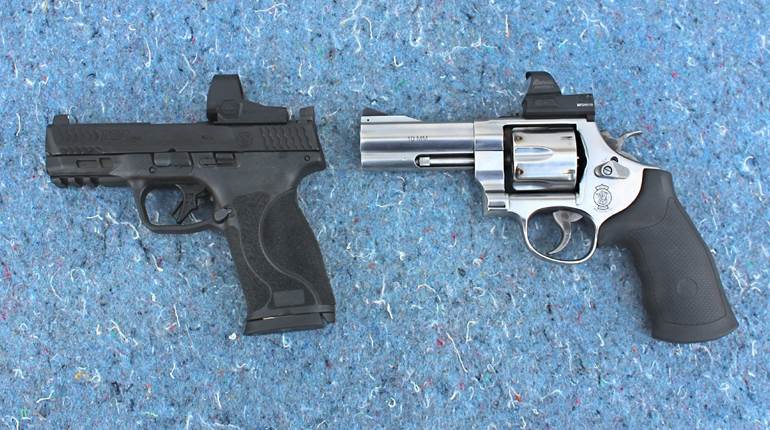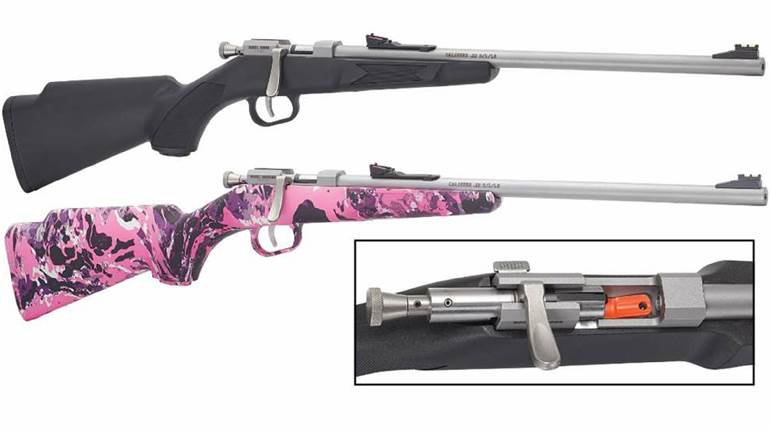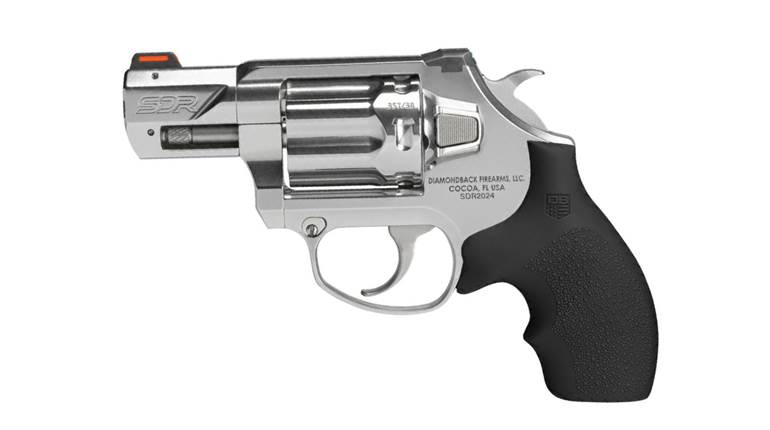
Perhaps the single most popular term used by gun geeks to describe today's AR-15 rifles is “modular.” Thanks to mil-spec standardization and the popularity of the AR platform, the marketplace is flush with easily interchanged components from dozens of manufacturers. One of the most notable modular design points is the rifle's ability to split into a complete upper and lower assembly.
This allows a single AR lower to be paired with multiple uppers in different calibers. Unfortunately, the “one lower to rule them all” approach does have its limitations. Although complete upper assemblies are less expensive than purchasing whole rifles, they are not necessarily cheap. The typical AR magazine well only accepts AR-type magazines which, in turn, can limit your caliber conversion options. If you want to use an optic then it must be paired to a certain upper or sighted in again when it's moved from one upper to another.
Windham Weaponry recently decided to take AR modularity to the next level and simplify the caliber conversion process with the new Multi-Caliber System (MCS) rifle platform. Employing their own in-house components, along with some technology licensed from MGI, this semi-automatic can be converted to fire different calibers using just one upper and lower assembly thanks to interchangeable barrels, bolt carrier groups (BCGs) and magazine wells. This review takes a closer look at the RMCS-4 rifle kit, which ships with four caliber options including 5.56 NATO (.223 Rem.), 300 BLK, 7.62x39 mm and 9 mm NATO (9 mm Luger).
The RMCS-4 rifle kit arrives in a heavy-duty, water resistant, lockable Plano carry case. This case not only protects the system during transport, it also provides a customized interior for storing all of the various components and a dirt-free work surface for converting the rifle in the field.
The MCS rifle provided in this kit is an M4 pattern gas-impingement operated carbine chambered in 5.56 NATO (.223 Rem.). At first glance, the MCS looks very much like other Windham M4s. The 16.12" long chrome-lined barrel is fitted with a Mil Std 1913 railed gas block, bayonet lug, sling swivel and a removable A2 flash hider. The flat top upper receiver and lower receiver are both CNC machined from 7075-T6 aluminum forgings and hardcoat anodized in a matte black finish. The other controls and features are all typical of the AR breed, including the 6-Postion Telestock, mil-spec charging handle, dust cover, forward assist, left-side safety lever, right-side magazine release, mil-spec trigger and polymer A2 pistol grip.
The two notable external differences of the MCS are found in the quad-rail handguard and the magazine well. When the handguard meets the upper receiver there's a heavy aluminum ring with two swing-out handles locked in place by a sliding retention block and bail. This is the device that allows the barrels to be removed from the upper without removing the handguard. The magazine well separates from the lower receiver just in front of the trigger and is supported by a pair of rails that allow it to slide up and off of the receiver.
Inside the case, along with the complete rifle, are three additional barrels, two removable magazine wells, two BCGs and three magazines including an aluminum 30-round Windham AR-15 Type for 5.56 and 300 BLK ammunition, a polymer 30-round Magpul PMAG 30 AK MOE for 7.62x39 mm, and a stainless steel 20-round Colt AR rifle type magazine made by ASC. There’s also a sling and a Safe Tech Safe-T-Round ejectable chamber flag with a fold out takedown punch.
All of the components are easily identified by their design and markings to avoid mixups during caliber conversions. The barrels are stamped with caliber and twist rates. The three rifle-caliber barrels have gas blocks and gas tubes while the 9 mm barrel does not. The 5.56 NATO and 7.62x39 mm BCGs both have rotary bolts. The neck of the 5.56 NATO bolt is smooth and the neck of the 7.62x39 mm bolt is marked with three rings. The blowback-operated 9 mm bolt is flat faced and does not have a gas key or rotary bolt. The magazine wells are all stamped with their respective calibers but it's easy to see which magazines fit which well. 
The number of components traded out for a caliber conversion depends on the rifle’s current configuration. To switch from 5.56 NATO to 300 BLK (or vice versa), only a barrel swap is required since these two calibers use the same BCG and magazine. Converting from one of those two calibers to either 7.62x39 mm or 9 mm NATO requires trading out the barrel, BCG and the magazine well.
Before conducting a caliber conversion of the MCS rifle, I highly recommend reading through the owner's manual and familiarizing yourself with all of the provided components first. This is best done at home while conducting the initial inspection, lubrication and bench checks. In fact, this particular system requires four bench checks, so it's best to complete them all before heading out to the shooting range.
The caliber conversion process is simple and can be completed in just a few minutes once you know the lay of the land. To convert the MCS rifle from one caliber to another, start by removing the magazine and verifying the rifle is completely unloaded. With the BCG in the forward position, separate the upper from the lower by depressing the takedown and pivot pins (just like any other AR carbine). Remove the BCG and charging handle from the upper receiver.
Flip the upper over so that you have access to the textured polymer retention block and bail. Press the bail up and off of the barrel retaining arms and then slide the tension block forward off of the retaining arms. Swing the two retaining arms out from the 12 o’clock to the 3 o’clock (right side) and 9 o’clock (left side) positions. This unlocks the barrel so that it can be pulled out of the upper receiver.
Guide the replacement barrel into the upper receiver.
Look through the upper receiver to ensure the barrel and gas tube are properly aligned and fully seated in place. Swing the retaining arms back into the 12 o’clock position, slide the retention block back over the arms and then lock the bail back in place. Replace the charging handle along with the BCG for the same caliber as the barrel. The upper is now ready to use.
To trade out the lower receiver's magazine well, start by depressing the spring-loaded retention pin located on the front right side of the trigger guard (use a small punch or 5.56 NATO bullet tip). Swing the trigger guard down and out of the magazine well. Depress the magazine release button to release the magazine well. While holding the magazine release down, slide the magazine well up and off of the lower receiver. Align the replacement magazine well with the lower receiver. While depressing the magazine release button, slide the magazine well down onto the lower receiver. Swing the trigger guard up and back into place.
Set the complete upper assembly on top of the lower receiver and pin the two halves back together. Run a quick check to make sure all the correct and necessary components are present and cycling smoothly. The barrel markings, BCG and magazine well can all be visually verified without dismantling the gun. If everything checks out, the rifle is now ready to fire a different caliber. With some practice, I soon had the conversion process down to a leisurely three minutes.
During my bench checks of the RMCS-4, I was impressed by the fit and finish throughout all of the components. Windham Weaponry's dedication to quality, which I've seen in other platforms, was clearly present in this system. When fully assembled, the MCS components fit tightly together as if each caliber option was the native chambering and yet remain easy to take apart even when the gun is hot and dirty.
At the shooting range, testing started with the rifle in its factory 5.56 NATO configuration and then progressed to the 300 BLK, 7.62x39 mm and finally the 9 mm. Including the bench checks, chronography, function checks and accuracy testing, the rifle was converted into each caliber between three to four times. Every conversion went smoothly without any breakages or hang ups. All of the rifle’s controls functioned properly with the better-than-most single stage mil-spec trigger exhibiting a 6 lb. trigger pull.
Although I expected this rifle to run properly, I appreciated the fact that it did not “play favorites.” In other words, there was the possibility that the MCS might run more reliably in some calibers than others. This was not the case. The gun ran problem free in each and every caliber. There were no magazine issues or ammunition malfunctions throughout the entire testing process.
A key reason for this level of reliability is the interchangeable magazine wells. Windham could have eliminated the need for interchangeable magazine wells by using AR-type 7.62x39 mm magazines instead of AK magazines and providing an insert to support the Colt 9 mm magazine. But these solutions have proved to be less than perfect in the past. By employing interchangeable magazine wells, the customer receives a precise magazine fit for proper feeding. I can't say for certain that the Windham MCS will run properly with absolutely every load of ammunition on the market in all four calibers all of the time. But during my time at the range with brass and steel case loads, ranging from practice to defense grade configurations, I experienced no malfunctions, and that's impressive.
One of the big questions folks will have about the MCS is this: How do the caliber swaps affect the down range point of impact when an optic is in use? If an optic is removed from one rifle (or upper assembly) and attached to another, it has to be sighted in again. The MCS rifle uses a single upper for all four calibers. Does it have to be sighted in again with each caliber conversion? The answer to the question is: It depends. The best way to explain that answer is to walk through what happened during the formal benchrested accuracy testing.
The MCS, with the 5.56 NATO (.223 Rem.) barrel assembly installed, was topped off with a Leupold VX-R Patrol 3-9x40 mm Firedot TMR optic and sighted in at 100 yards using Birchwood Casey 12"x18" Shoot-N-C silhouette targets. Federal Premium Fusion 62-gr. soft points turned in a 1.46" five group average at this range.
The 5.56 NATO barrel was then traded out for the 300 BLK barrel. Without adjusting the scope, the 300 BLK barrel shifted the point of impact 11" up and 3" to the right of the 5.56 NATO barrel. Although this was more of a shift than I'd hoped for, it did allow the scope to be re-zeroed at 100 yds. without moving the target. Once zeroed, Gorilla Ammunition's .300 BLK 125-gr. Sierra Match King open tip rounds yielded a group average of 1.68".
The rifle next underwent a complete caliber conversion (barrel, BCG and magazine well) to 7.62x39 mm. With the scope still set to the 300 BLK barrel's zero, the 7.62x39 mm barrel exhibited a 5" drop without a notable level of horizontal shift. This smaller degree of shift in the point of impact is similar to what one expects when changing ammunition brand or bullet weight. Once again, a few shots at 100 yards without moving the target forward or back and the optic was zeroed and ready to go. Winchester Super X 123-gr. soft points produced a group average of 1.73".
The results indicate that only modest scope adjustments are required when switching between the three rifle caliber, gas-impingement operated barrels. Just make sure to give yourself about a foot of space to work with around the target center.
However, the scope zero does not transition when the rifle is converted to 9 mm. Shots fired using the optic zeroed to the 7.62x39 mm barrel did not strike the target at 100 or 50 yards. So the target stand was wheeled all the way back to the starting point and the rifle was re-zeroed from scratch out to 50 yrds. At this distance, the 9 mm barrel produced a 1.74" group average using HPR's HyperClean 115-gr. full-metal jacket loads.
For those who are wondering, the 9 mm NATO cartridge has the identical exterior dimensions as the popular 9 mm Luger (or just 9 mm) pistol cartridge that's commonly found in today's defensive pistols. The difference between the two is the level of pressure they produce. The 9 mm NATO generates 10 to 15 percent higher pressure levels than standard cartridges. This means the pressure of the 9 mm NATO is on par with civilian 9 mm +P rounds. So, the short answer to the long question is yes, the MCS 9 mm conversion can comfortably digest a regular diet of standard velocity and +P 9 mm ammunition. 
I'm a shooter who approaches caliber convertible platforms with a degree of caution. Simply stated, some work and some don't. I'm glad to report that, based on the time I've spent converting and shooting the Windham Weaponry RMCS-4 rifle kit, this company's MCS platform is reliable and easy to use. I understand that some folks will flinch when they see the suggested retail price of $2971. But a bit of research quickly reveals that compared to the cost of buying and accessorizing a quality AR-15 with three additional uppers, magazines and optics, the RMCS-4 is a good deal. If you're not in the market for a four-caliber rifle, Windham weaponry offers two-caliber and three-caliber kits along with a wide variety of single-caliber AR-15s. 
NRA Specifications
Manufacturer: Windham Weaponry
Model: RMCS-4 Four Caliber Rifle Kit
Action: Gas-Impingement Semi-Automatic & Blow Back Operated
Four Calibers: 5.56 NATO (.223 Rem), 300 BLK, 7.62x39 mm, 9 mm NATO
Upper Receiver: MCS Flat-Top Forged 7075-T6 Aluminum, Matte Black Hard Coat Anodized
Hand Guard: Integral Railed Free-Float with Barrel Retention Block
Dust Cover: Yes
Forward Assist: Yes
Charging Handle: Mil-Spec
Sights: None, Integral Optics Rail
Lower Receiver: MCS Interchangeable Mag Well, Forged 7075-T6 Aluminum, Matte Black Hard Coat Anodized
Magazine Wells: Forged 7075-T6 Aluminum, Matte Black Hard Coat Anodized
Shoulder Stock: 6-Position Telestock
Trigger: Mil-Spec Single Stage
Trigger Pull: 6 lbs.
Pistol Grip: A2 Black Polymer
Rifle Caliber Barrels: 16.12" M4 Profile, 4150 Chromoly Steel, Hard Chromed Bore, Black Manganese Phosphate Finish, Mil Std 1913 Railed Gas Block, Bayonet Lug, Sling Swivel, A2 Flash Hider
9 mm NATO Barrel: 16.12" M4 Profile, 4150 Chromoly Steel, Black Melonite Finish, A2 Flash Hider
Rifle Caliber Bolt Carrier Groups: Rotary Bolt, Gas Impingement Operated
9 mm NATO Bolt Carrier Group: Fixed Bolt, Blow-Back Operated
Magazines: One Aluminum 30-round Windham AR-15 Type, One Polymer 30-round Magpul PMAG 30 AK MOE, One 20-round Colt Type ASC Stainless Steel
Overall Length: 32.50” Stock Collapsed, 36.25" Stock Extended
Length of Pull (LOP): 10.50" - 14.25"
Weight: 7 lbs. Unloaded (Factory Configuration with No Magazine)
Twist & Rifling Rates: 5.56 NATO 1:9" RH 6-Groove Rifling, 300 BLK 1:7" RH 5-Groove 5R Rifling, 7.62x39 mm 1:9.5" RH 4-Groove Rifling , 9 mm NATO 1:10" RH 6-Groove Rifling
Accessories: Heavy Duty Lockable Custom Carry Case, Sling, Owner's Manual
MSRP: $2971





































